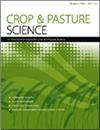Screening and field evaluation of white clover rhizobia for New Zealand pastures
IF 1.9
4区 农林科学
Q2 AGRICULTURE, MULTIDISCIPLINARY
引用次数: 0
Abstract
ABSTRACT Context. Biological nitrogen (N) fixation through the rhizobia–legume symbiosis is a sustainable and cost-effective source of N for agriculture. In New Zealand (NZ), white clover (Trifolium repens) is a key component of pastures and rhizobial inoculation of clover is widely used. The current commercial inoculant for white clover, TA1, was isolated in Australia in the 1950s and may not be the best partner for modern white clover cultivars. Aims. To identify Rhizobium leguminosarum bv. trifolii (Rlt) isolates suitable for use in NZ pastures. Methods. The symbiotic potential of >230 isolates collected from throughout NZ was evaluated in plant bioassays. Selected isolates were further evaluated in pot and field trials. Key results. Approximately 40% of NZ isolates supported better clover growth than TA1 under N-limited conditions in vitro. Of 24 Rlt isolates evaluated in a glasshouse trial, five produced significantly higher clover biomass than TA1. Three (S11N9, S20N7, S4N6) of nine isolates evaluated in two field trials in 2018–2019 significantly increased clover growth (12–38%) compared with paired uninoculated clover at several harvests, whereas inoculation with TA1 did not improve yield. In a third trial in 2020, S11N9 and S20N7 increased clover growth compared with the uninoculated control at two of three harvests; S4N6 performed better than TA1 at one harvest. When tested with four white clover cultivars, five Rlt isolates had higher symbiotic potential than TA1. Conclusions. Inoculating white clover would be beneficial if improved inoculant isolates were available. Implications. We recommend some NZ Rlt isolates could be developed into commercial inoculants to improve white clover performance in NZ.新西兰牧场白三叶草根瘤菌的筛选与田间评价
本文章由计算机程序翻译,如有差异,请以英文原文为准。
求助全文
约1分钟内获得全文
求助全文
来源期刊

Crop & Pasture Science
AGRICULTURE, MULTIDISCIPLINARY-
CiteScore
4.20
自引率
15.80%
发文量
111
审稿时长
3 months
期刊介绍:
Crop and Pasture Science (formerly known as Australian Journal of Agricultural Research) is an international journal publishing outcomes of strategic research in crop and pasture sciences and the sustainability of farming systems. The primary focus is broad-scale cereals, grain legumes, oilseeds and pastures. Articles are encouraged that advance understanding in plant-based agricultural systems through the use of well-defined and original aims designed to test a hypothesis, innovative and rigorous experimental design, and strong interpretation. The journal embraces experimental approaches from molecular level to whole systems, and the research must present novel findings and progress the science of agriculture.
Crop and Pasture Science is read by agricultural scientists and plant biologists, industry, administrators, policy-makers, and others with an interest in the challenges and opportunities facing world agricultural production.
Crop and Pasture Science is published with the endorsement of the Commonwealth Scientific and Industrial Research Organisation (CSIRO) and the Australian Academy of Science.
 求助内容:
求助内容: 应助结果提醒方式:
应助结果提醒方式:


